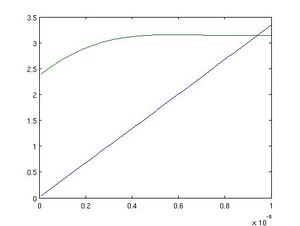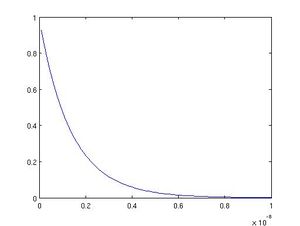Difference between revisions of "Mapping diamond surfaces using interference"
| Line 2: | Line 2: | ||
| − | ==Electromagnetic | + | ==INTERFERENCE AND LIGHT WAVES== |
| + | Light (electromagnetic radiation) [[Image:emwave.jpg|thumb|An Electromagnetic Wave! (courtesy of [http://www.mtholyoke.edu/~mlyount/MySites/ForensicSpectroscopy/Vocab.html])]] is comprised of an temporally and spatially oscillating electric and magnetic field components. These components are orthogonal to each other as well as to the direction of propagation given by the Poynting vector. Wave equations for the electric and magnetic fields can be derived using [[Maxwell's Equations]]. | ||
| + | Something about plane wave solutions here. | ||
| + | Electromagnetic waves also have the property that they interfere. [[Image:MichIntInt.jpg|thumb|Interference from a Michelson Interferometer (courtesy of [http://www.arikah.com/encyclopedia/Interference])]] Like interfering mechanical waves, EM waves can interfere destructively or constructively depending on the phase difference between the two waves. In order for this to occur, the light waves must be traveling in the same direction, be of the same wavelength and have “a constant phase with respect to each other” (Serway and Jewett 1177). A picture of EM wave interference is shown at right. | ||
| + | |||
| + | ==INTERFEREOMETRY AND THE MICHELSON INTERFEROMETER== | ||
| + | Interferometry is the splitting of light beams into two or more paths and the recombining of those different beams to measure “difference in optical path, length and refractive index” (Candler 9) via interference fringes that form as a result of the recombined beams. | ||
| + | The Michelson interferometer [[Image:MIint.gif|thumb|A Michelson Interferometer! (courtesy of [http://scienceworld.wolfram.com/physics/MichelsonInterferometer.html])]] was invented by Albert Michelson in 1882 “to detect a change in the velocity of light due to the motion of the [ether]” (110). The findings of Michelson's experiment eventually went on to support Einstein's theory of relativity. | ||
| + | For our experiment we will be utilizing the fringes of the Michelson interferometer to gather information about the topology of synthetic diamond wafers. | ||
| + | |||
| + | [[Maxwell's Equations]] | ||
| + | |||
| + | |||
| − | |||
| − | |||
| − | |||
| − | |||
| − | |||
| − | |||
| − | |||
| − | |||
A simplistic approximation | A simplistic approximation | ||
| Line 20: | Line 24: | ||
[[Maxwell's Equations]] | [[Maxwell's Equations]] | ||
| − | |||
| − | |||
| − | |||
| − | |||
| − | |||
| − | |||
| − | |||
| − | |||
| − | |||
| − | |||
| − | |||
| − | |||
| − | |||
| − | |||
| − | |||
| − | |||
| − | |||
| − | |||
| − | |||
| − | |||
Revision as of 13:22, 14 March 2007
This page represents a ongoing project dealing with using interference patterns to map the surface of a diamond wafer. Since this is my first page, you'll have to excuse any blatant errors that I do not pick up on immediately. Currently this page will represent my work with Dr. Richard Jones on an approximation to the beam splitter featured in the Michelson interferometer. I will start by giving a brief introduction to electromagnetic radiation, then move on to the approximation itself (including graphs,etc.). I will hopefully have this up and running by next Wednesday.
INTERFERENCE AND LIGHT WAVES
Light (electromagnetic radiation)
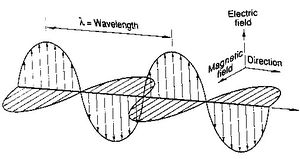
is comprised of an temporally and spatially oscillating electric and magnetic field components. These components are orthogonal to each other as well as to the direction of propagation given by the Poynting vector. Wave equations for the electric and magnetic fields can be derived using Maxwell's Equations.
Something about plane wave solutions here.
Electromagnetic waves also have the property that they interfere.
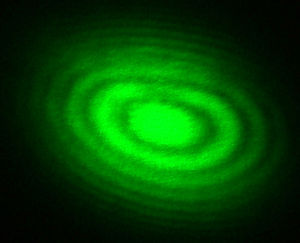
Like interfering mechanical waves, EM waves can interfere destructively or constructively depending on the phase difference between the two waves. In order for this to occur, the light waves must be traveling in the same direction, be of the same wavelength and have “a constant phase with respect to each other” (Serway and Jewett 1177). A picture of EM wave interference is shown at right.
INTERFEREOMETRY AND THE MICHELSON INTERFEROMETER
Interferometry is the splitting of light beams into two or more paths and the recombining of those different beams to measure “difference in optical path, length and refractive index” (Candler 9) via interference fringes that form as a result of the recombined beams.
The Michelson interferometer
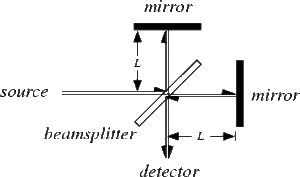
was invented by Albert Michelson in 1882 “to detect a change in the velocity of light due to the motion of the [ether]” (110). The findings of Michelson's experiment eventually went on to support Einstein's theory of relativity.
For our experiment we will be utilizing the fringes of the Michelson interferometer to gather information about the topology of synthetic diamond wafers.
A simplistic approximation
